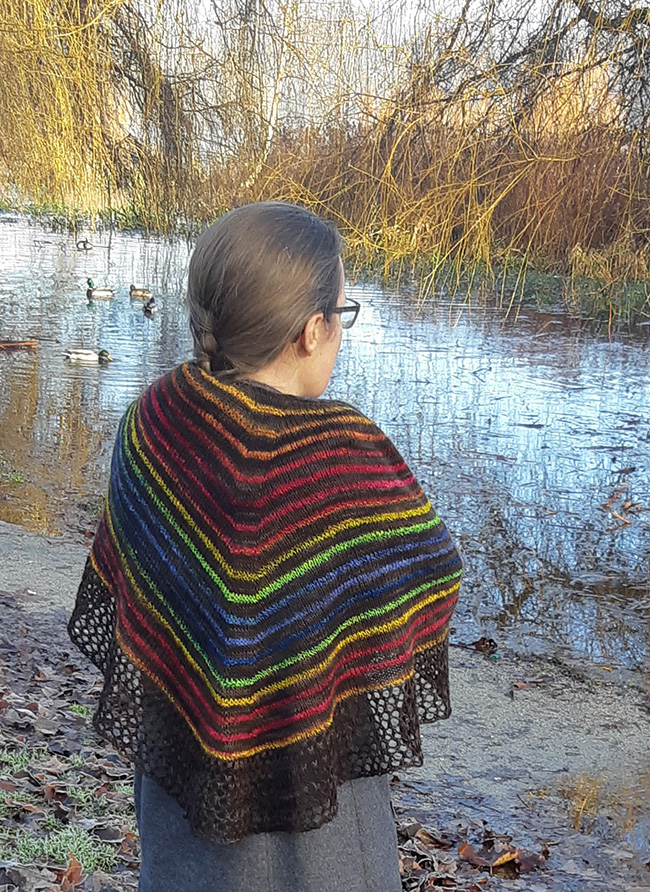Vaunt, a free knitting pattern from Knitty.com. Free knitting pattern for a combination handspun and commercial yarn striped shawl with a simple lace border. Commercial yarn alternative is provided for the handspun.
INTRODUCTION
Vaunt
 by Sarah Thornton
by Sarah Thornton
![]()
It was one of those fiber festival impulse purchases – I walked by the tent and a vibrant braid of fiber caught my eye. But it was only 2 ounces. How could I showcase a small amount of handspun yarn while still making a larger project? Commercial yarn to the rescue (of course, you can use handspun for both yarns!). The handspun yarn is the star in this shawl. The rainbow was dyed on a bi-color Corriedale top – a top that contained stripes of both white and brown Corriedale – which lent an earthy richness to the dyed fiber and resulting yarn. I split the fiber down the middle and spun two singles, then plied them together, allowing a small amount of barber-poling when the color stretches didn't line up.
Handspun can be tricky – how far will that yardage actually stretch? In many cases you can't get more fibre to spin – you have what you have, and that's it. I didn't want to get caught short so I designed a pattern that is completely flexible with the amount of showcase yarn.
Vaunt is a modified heart-shaped shawl made with alternating stripes of vibrant handspun and a tonal main color, finished with a simple lace trellis edging. It looks best with the background yarn slightly thinner than your handspun yarn. Make sure the colours contrast well.
 model: Sarah Thornton
model: Sarah Thornton
 photos: Doug Robinson
photos: Doug Robinson
SIZE
One
FINISHED MEASUREMENTS
Wingspan: 56 inches / 142 cm
Depth: 23 inches / 58 cm
MATERIALS
Yarn
![]() [MC] Georgian Bay Fibre Co Bayfield Fingering [100% Blue Faced Leicester; 2 ply, 378y per 115g skein]; color: Iron; 1 skein
[MC] Georgian Bay Fibre Co Bayfield Fingering [100% Blue Faced Leicester; 2 ply, 378y per 115g skein]; color: Iron; 1 skein
Fiber
![]() [CC] Humming Bee Farms [Corriedale bi-color; top]; color: Rainbow; 2 ounces / 58g
[CC] Humming Bee Farms [Corriedale bi-color; top]; color: Rainbow; 2 ounces / 58g
Finished Yarn
Wraps per inch: 12
Ply: 2
Yardage used: MC: 378 y/346 m / CC: 138 y/125 m
Drafting method: forward worsted
Commercial yarn alternative
![]() [CC] Cascade Yarns Venezia Sport Multis [70% merino, 25% silk; 307.5y per 100 g skein]; 1 skein
[CC] Cascade Yarns Venezia Sport Multis [70% merino, 25% silk; 307.5y per 100 g skein]; 1 skein
Indie dyer alternative
![]() [CC] Small Bird Workshop BFL Gotland blend DK weight yarn [75% Blue Faced Leicester, 25% Gotland; 250 yards per 100g skein]; 1 skein
[CC] Small Bird Workshop BFL Gotland blend DK weight yarn [75% Blue Faced Leicester, 25% Gotland; 250 yards per 100g skein]; 1 skein
or
![]() [CC] Crafty Jak Delicious DK [100% Blue Faced Leicester; 260y per 115g skein]; 1 skein
[CC] Crafty Jak Delicious DK [100% Blue Faced Leicester; 260y per 115g skein]; 1 skein
Yarn Characteristics: The shawl was designed to showcase the contrasting colour, so if you are substituting commercial yarn, make sure to pick a yarn with character. Look for a yarn that compliments the main colour while still making a statement – vivid colours, more texture, and some lustre. A yarn with Blue Faced Leicester or Gotland will provide shine, as would a silk blend yarn. A sport to DK weight gradient-dyed yarn would work beautifully.
Recommended needle size[always use a needle size that gives you the gauge listed below - every knitter's gauge is unique]
Notions
![]() stitch markers (2)
stitch markers (2)
![]() kitchen scale (optional)
kitchen scale (optional)
![]() yarn needle
yarn needle

GAUGE
18 sts/30 rows = 4 inches/10cm in stockinette stitch
PATTERN NOTES
[Knitty's list of standard abbreviations and techniques can be found here.]
Shawl is worked flat.
This modified heart-shaped shawl is worked from the center of the upper edge outwards, so the size can be easily customized. Heavier weights of yarn can also be substituted; adjust needle size to suit yarn choice. Carry the CC loosely up the sides and capture it with the MC every two rows.
Changing Size:
This shawl pattern is designed to work with you, not against you. You can work the shawl until you reach the depth you like or until you run out of the CC yarn. The lace edging can be worked on any odd number of stitches – if you follow the pattern as written, you will have an odd number of stitches once you have finished the CC. A kitchen scale can be useful – weigh your CC carefully as you get close to the end of your supply and see how much it takes for one stripe. Each stripe takes slightly more yarn than the last, so make sure to leave enough yarn to get a full stripe (two rows) in at the end.
M1Rp:
Insert left needle, from back to front, under the horizontal strand which lies between the stitch just knit, and the following stitch; then purl into the front of this loop. 1 stitch increased.
M1Lp:
Insert left needle, from front to back, under the horizontal strand which lies between the stitch just knit, and the following stitch; then purl into the back of this loop. 1 stitch increased.
DIRECTIONS

Using MC and the Long Tail Method, CO 13 sts.
Row 1 [WS]: K2, M1R, k to last 2 sts, M1L, k2. 15 sts.
Row 2 [RS]: (K2, M1R) twice, pm, k7, pm, M1L, k2, M1L, k2. 19 sts
Row 3: K2, M1Rp, p to last 2 sts, M1Lp, k2. 21 sts.
Body Pattern:
Note: For ease of keeping track, all RS rows are the same; On the WS, Rows 2 and 4 are the same, but Row 6 is worked slightly differently. Work Rows 1–4 with MC, and Rows 5–6 with CC.
Row 1 [MC] [RS]: K2, M1R, k to m, M1R, sm, k to m, sm, M1L, k to last 2 sts, M1L, k2. 4 sts increased.
Row 2 [MC] [WS]: K2, M1Rp, p to last 2 sts, M1Lp, k2. 2 sts increased.
Row 3 [MC]: K2, M1R, k to m, M1R, sm, k to m, sm, M1L, k to last 2 sts, M1L, k2. 4 sts increased.
Row 4 [MC]: K2, M1Rp, p to last 2 sts, M1Lp, k2. 2 sts increased.
Row 5 [CC]: K2, M1R, k to m, M1R, sm, k to m, sm, M1L, k to last 2 sts, M1L, k2. 4 sts increased.
Row 6 [CC]: K2, M1Rp, p to m, k7, p to last 2 sts, M1Lp, k2. 2 sts increased.
Repeat Rows 1–6, twisting MC and CC around each other between Rows 2–3, until you run out of CC or the shawl is desired depth to edging.
Work Rows 1–2 once more.
Edging:
Row 1 [RS]: K2, M1R, K1, *(YO, K2tog) rep from * to last 2 sts, M1L, k2. 2 sts increased.
Row 2 [WS]: K2, M1Rp, p to last 2 sts, M1Lp, k2. 2 sts increased.
Row 3 [RS]: K2, M1R, *SSK, YO rep from * to last 3 sts, K1, M1L, k2. 2 sts increased.
Row 4 [WS]: K2, M1Rp, p to last 2 sts, M1Lp, k2. 2 sts increased.
Repeat Rows 1–4 until piece is desired length, or you have 2-3 rows' worth of yarn remaining, ending with a WS row.
Bind off as follows:
K1, *K1, slip 2 stitches back to LH needle, K2togtbl, repeat from * to end. Fasten off.
FINISHING
Weave in ends using yarn needle. Soak in sink of tepid water with a drop of wool wash for 20 minutes. Squeeze out the water with a towel and spread the shawl onto a blocking mat or towel. Pin the bottom edge into a gentle curve (flexible blocking wires really help here!). Allow to sit until completely dry.
ABOUT THE DESIGNER
 Sarah teaches knitting, spinning, and college-level Biology in the south-west corner of British Columbia. She started as an ocean scientist and still loves getting out to sea, even if only on a BC Ferry. She used to teach at a LYS but since March 2020 has been teaching via Zoom using her simple patterns for beginner knitters.
Sarah teaches knitting, spinning, and college-level Biology in the south-west corner of British Columbia. She started as an ocean scientist and still loves getting out to sea, even if only on a BC Ferry. She used to teach at a LYS but since March 2020 has been teaching via Zoom using her simple patterns for beginner knitters.
Find more information on her website.
Pattern & images © 2021 Sarah Thornton